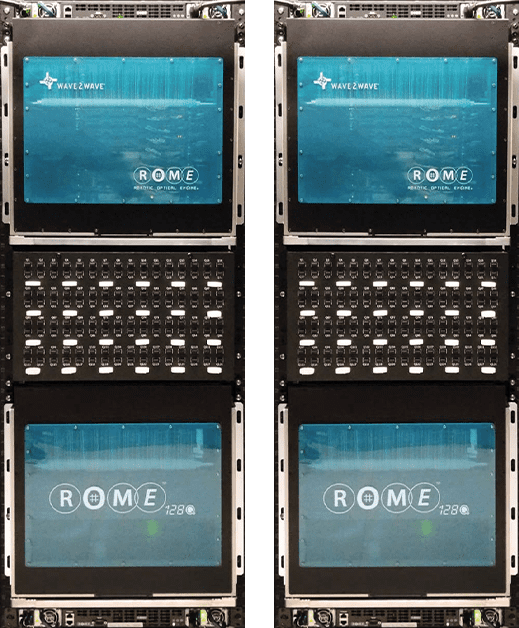In the ever-evolving landscape of network infrastructure, where speed, scalability, and automation are paramount, FiberSmart’s ROME Q Series stands out as a pioneering solution. Part of the broader Robotic Optical Management Engine (ROME) family, the Q Series is purpose-built to address the demands of high-speed optical transceiver interfaces in modern data centers, telecom networks, and beyond. With models like the ROME 64Q and 128Q, this series brings robotic precision to the physical layer, supporting everything from 40G to 800G connectivity. Let’s explore what makes the ROME Q Series a standout and dive into its key features, benefits, and ideal use cases as of February 26, 2025.
What is the ROME Q Series?
The ROME Q Series is a line of robotic fiber switches designed to automate and optimize physical layer connectivity in high-bandwidth environments. Unlike traditional manual patching systems, these switches use software-directed robots to manage fiber connections, leveraging Multiple-Fiber Push-On/Pull-off (MPO) interfaces for seamless integration with high-speed optical transceivers like QSFP (Quad Small Form-factor Pluggable) devices. The series includes the ROME 64Q, offering 64 non-blocking 8-fiber MPO ports (512 fibers total), and the ROME 128Q, doubling that to 128 ports (1,024 fibers). For even greater flexibility, the ROME Q Double Density (DD) platforms support 16-fiber MPO interfaces, catering to next-gen applications.
What sets the Q Series apart is its ability to deliver “any-to-any” connections—meaning any port can connect to any other port without blocking—combined with features like breakout and loopback capabilities. With a typical insertion loss of just 0.5 dB and a robust mechanical latching system that ensures stability even during power outages, the ROME Q Series is engineered for reliability and performance. Its 11RU (rack unit) chassis fits standard 19-inch racks, making it a practical choice for space-conscious deployments, while its software interface allows remote reconfiguration via a simple drag-and-drop GUI (Graphical User Interface).
Key Features and Benefits
- High-Speed Support: Compatible with 40G, 100G, 400G, and 800G interfaces, the Q Series aligns with the bandwidth demands of today’s AI-driven, cloud-based, and 5G-powered networks.
- Robotic Automation: Eliminates manual patching, reducing human error and enabling rapid, remote reconfiguration in as little as 15 seconds per switch.
- Scalability: The 64Q and 128Q models cater to varying port densities, while hybrid MPO/LC patch panel options allow customization to specific needs.
- Resilience: Patented mechanical latching keeps connections intact during power failures, and redundant, hot-swappable power supplies (50-150 watts) ensure uptime.
- Future-Proof Design: Protocol, wavelength, and bitrate agnostic, it’s ready for tomorrow’s network innovations.
- Cost Efficiency: By automating labor-intensive tasks, it slashes operational expenses (OPEX) and minimizes the need for on-site technicians.
Use Cases Where ROME Q Series Excels
- Hyperscale Data Centers: Managing Massive Bandwidth
- Why It Fits: Hyperscale facilities, like those run by Google or AWS, handle astronomical data volumes, often requiring frequent reconfiguration to balance loads or integrate new hardware. The ROME Q Series’ high port density (up to 1,024 fibers) and support for 400G/800G interfaces make it a perfect match.
- Real-World Impact: During a traffic surge, a hyperscaler can use the 128Q to reroute connections across QSFP transceivers in seconds, optimizing bandwidth without sending a single technician onsite.
- Benefits: Enhanced agility, reduced downtime, and lower labor costs in sprawling, high-stakes environments.
- AI and Machine Learning Workloads: Feeding the Compute Beast
- Why It Fits: AI training and inference demand ultra-low latency and massive bandwidth, often relying on leaf-spine architectures with dense fiber interconnects. The Q Series’ non-blocking MPO ports ensure seamless east-west traffic flow between servers.
- Real-World Impact: A tech firm training a large language model can deploy the 64Q to dynamically adjust fiber links, prioritizing compute clusters as workloads shift—all managed remotely from a cloud dashboard.
- Benefits: Faster model training, efficient resource allocation, and zero-touch scalability.
- Telecom Core Networks: Powering Carrier-Grade Connectivity
- Why It Fits: Telecom operators need robust, high-speed backbones to support 5G and cloud services. The ROME Q Series integrates with QSFP28 and QSFP-DD transceivers, delivering the flexibility to handle unpredictable traffic patterns.
- Real-World Impact: A carrier can use the 128Q at a metro hub to instantly reconfigure fiber paths during a fiber cut, maintaining service continuity without costly truck rolls.
- Benefits: Improved uptime, rapid service provisioning, and reduced maintenance overhead.
- Network Testing Labs: Accelerating Innovation
- Why It Fits: R&D labs testing next-gen optical gear—like 800G transceivers—require frequent topology changes. The Q Series’ breakout and loopback features, paired with robotic precision, make it a lab favorite.
- Real-World Impact: Engineers at a fiber optics firm can simulate 100G-to-400G upgrades using the 64Q, reconfiguring test setups in real time to validate performance metrics.
- Benefits: Quicker iteration cycles, error-free connections, and a scalable testbed for cutting-edge tech.
- Content Delivery Networks (CDNs): Optimizing Streaming
- Why It Fits: CDNs like Akamai or Cloudflare rely on high-speed fiber to deliver 4K/8K video and VR content with minimal latency. The Q Series’ MPO interfaces and automation keep edge caches connected efficiently.
- Real-World Impact: During a live sports event, a CDN operator uses the 128Q to shift fiber links, prioritizing streaming traffic to high-demand regions—all from a coffee shop laptop.
- Benefits: Enhanced viewer experience, dynamic load balancing, and cost-effective scaling.
Why ROME Q Series Matters in 2025
As networks race to keep up with AI, IoT, and 5G, the physical layer has lagged behind the software-defined revolution—until now. The ROME Q Series bridges that gap, injecting robotic intelligence into fiber management. Manual patching is a relic of the past; with labor shortages, remote deployments, and rising OPEX pressures, automation is no longer optional. The Q Series’ ability to handle 1,024 fibers in a single chassis, support bleeding-edge speeds, and operate autonomously puts it at the forefront of this shift.
Skeptics might question the need for robotics in fiber switching, but the numbers tell the story: human error accounts for 70% of network downtime, and truck rolls can cost thousands per incident. The ROME Q Series mitigates those risks while delivering a lifespan of 3 million cycles—decades of reliable service. Integrated with SDN (Software-Defined Networking), it’s not just a switch; it’s a strategic asset for operators aiming to stay competitive.











